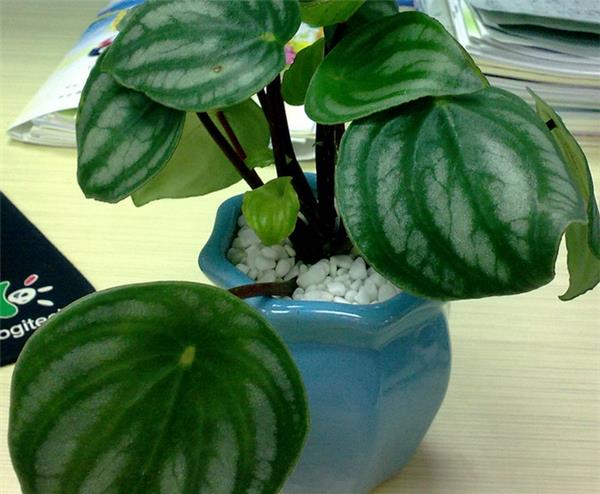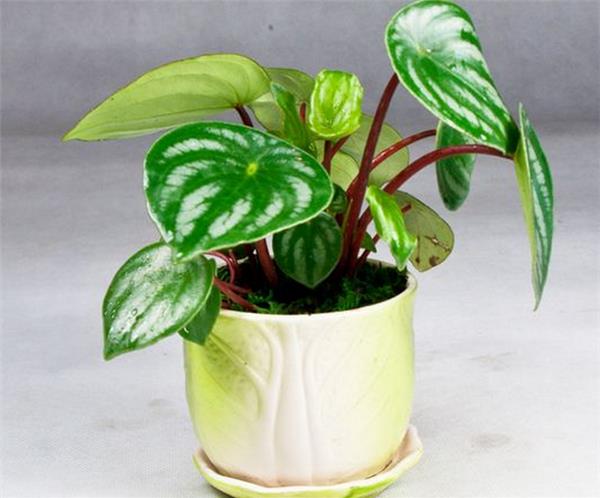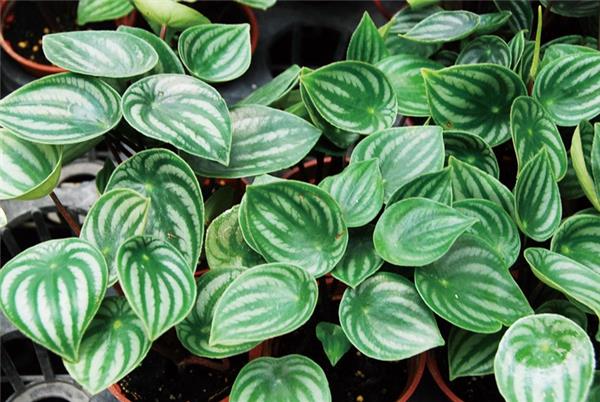The function of watermelon peel pepper grass
Watermelon pepper grass is now one of the common family potted plants, many families have planted, but do you know what are the functions of watermelon pepper grass? Let's give a brief introduction.

Brief introduction of watermelon and pepper grass
Watermelon pepper grass, also known as bean green pepper grass, is a perennial herb, evergreen all the year round. The stem is short and tufted, and the petiole is reddish brown. Leaves ovoid, tail tip pointed, about 6cm. Leaf veins radiate from the center to all sides, 8 main veins, dark green, silver gray between veins, shaped like watermelon peel, hence the name watermelon peel pepper grass.
Watermelon peel pepper grass likes warm, humid and semi-shady environment. Summer and autumn high temperature and drought season should pay attention to often spray the leaf surface to keep the leaf surface moist. If you water too much, the stems and leaves will rot easily. The cultivation substrate should be loose and well drained and ventilated. The cold resistance is slightly weaker, and the winter temperature should be kept above 8 ℃. The growth was the best at 20 ℃ 25 ℃, while it grew slowly when it was over 30 ℃ and below 15 ℃. Excessive nitrogen fertilizer can easily lead to insignificant markings and reduce the ornamental value.
Watermelon pepper grass plant shape is short, luxuriant growth, whether as a pot decoration, or hanging appreciation are very suitable. Its leaves are striped like watermelons. It is suitable for pot cutting or hanging cultivation.

The function of watermelon peel pepper grass
1. Decorate the home
Watermelon pepper grass plant shape exquisite, show leaves Cong Niu, the shape is round, as green as jade, white if beautiful jade, elegant Jie Jiaoying, used as interior decoration plant unique charm. Can be used as a small potted plant on the coffee table, desk, watch carefully, unique flavor, is a very suitable desk decoration of small foliage plants, used in the home is a good helper for embellishment and beautification.
2. Purify the air
Watermelon pepper grass is a master of embellishment and beautification of home, and it is not bad in purifying and improving indoor air. Watermelon pepper grass has strong photosynthesis, can absorb a lot of carbon dioxide and release a lot of oxygen, and is resistant to sulfur dioxide to a certain extent. it can also absorb a small amount of formaldehyde and ammonia, and has a strong absorption effect on oil fume and dust. it is a very strong plant for purifying and improving the air, and it is very good to be used in the home.
3. Home fengshui
The vigorous growth of watermelon pepper grass leaves is round, green and smooth, with auspicious and healthy feng shui meaning, but also means that it can be more smooth to adapt to a variety of different environments and characters, and has a good feng shui meaning to the host's health and communication. Can be arranged for home fengshui.

Finally, let's take a look at the propagation method of watermelon pepper grass.
Common ramet and cuttings are propagated:
Ramet propagation
Can be carried out in the spring and autumn, select the plant with new buds at the root of the mother plant, combined with turning the basin to change the soil to take out the plant, shake off the attached soil, and use a sharp knife to cut the new bud potted plant according to the position of the new bud. When ramet, pay attention to protect the root system of the mother plant and the new bud. It can also be poured out and divided into several pots when the plant is full of pots.
Cuttings propagate: cuttings are branched and leafy.
The main results are as follows: (1) Branch insertion can be carried out in spring and summer, select strong branches, cut 5-8 cm scions, remove the lower leaves, dry the cut, and then insert them into the wet sand bed. It can take root at a temperature of 18-25 ℃ in semi-shade.
(2) Leaf cuttings are mostly carried out from May to October. When inserting leaves, choose strong and full leaves, take off all the full leaves with petioles, take petioles of 2-3 cm, dry for 2-3 hours after the wound is slightly dry, and insert them obliquely in the sand bed or basin, the angle between the petiole and the seedling bed is 35 ~ 45 degrees, and the matrix is mixed with washed river sand with 20% vermiculite of 30%. Keep it moist, put it in half-shade, 20: 25 ℃, about 4: 5 weeks can produce adventitious roots and buds, and about 2 months can grow into seedlings. When the seedling grows to 4-5 cm, it is transplanted into the basin. But avoid the medium too wet, to avoid cuttings rot. Avoid covering it with plastic film or glass when inserting it, otherwise it will rot easily.

This is the end of the introduction about the role of watermelon and pepper grass today. I hope the above content can be explained to everyone!
Related
- Wuhan Hospital Iron Tree Blooming Result Was Instantly Frightened by the Gardener Master
- Which variety of camellia is the most fragrant and best? Which one do you like best?
- What is the small blue coat, the breeding methods and matters needing attention of the succulent plant
- Dormancy time and maintenance management of succulent plants during dormancy
- Minas succulent how to raise, Minas succulent plant pictures
- What are the varieties of winter succulent plants
- How to raise succulent plants in twelve rolls? let's take a look at some experience of breeding twelve rolls.
- Attention should be paid to water control for succulent plants during dormant period (winter and summer)
- Watering experience of twelve rolls of succulent plants
- Techniques for fertilizing succulent plants. An article will let you know how to fertilize succulent plants.



